QuestionQUESTION: Hi Diane,
We have just bought a leopard gecko from a breeder. It will be a year this
May. We have it in a 10 Gal. tank, reptile carpet, undertank heater, wet and
dry hide, water dish. First it hasn't eaten since we got about a week ago. We
have tried both crickets and meal worms-in a dish. But we think it may be
due to inadequate heat which we are fixing - question re: this later. Also, we
can't tell if it is drinking. There is so much conflicting info out there on
habitat and feeding and treating water...
Question 1: Do we need to treat our filtered water before giving it to her?
Question 2: We believe that it may be too cold (which is why she isn't eating)
with just the tank heater so we are getting a top light today. Is there any
difference between a "heat" light that pet stores sell and a household
lightbulb? Pet store people say yes, websites say no. Which to believe?
Question 3: How long should we leave the crickets in the tank when we feed
her and how many should she be eating?
Question 4: Lastly, at what age are they considered an adult. Some books
refer to adult eating habits - but I don't know if she is an adult??
Sorry for all the questions - especially if you have answered these before.
Thank you for your help.
Anne
ANSWER: Hi Anne,
I am going to include a basic care sheet that I wrote to help you out. You will find your questions answered there..but will also give the "short" version of the answers .
1.Don't worry too much about not eating yet..as long as she has a nice fat tail it shouldn't be a problem. They do take time to get adjusted to a new home..they really hate change. Double check your temperatures, as you said, may be a reason as to why not eating. Don't offer food for a day or two..this may get her interested.
2. Misting the plants and the tank sides is how most get their water. One of mine likes to drink when I am pouring fresh water into her dish.
3. Technically, they are considered adults when they reach sexual maturity which is about 12-15 months of age.
4. Your water should be fine, since its filtered.
5. Yes, there is a difference in the bulbs actually... regular incandescent bulbs don't put out any uva. Heat lights from the pet store are generally called basking bulbs..and most put out the uva. What I use for overhead is a heat emitter(these emit no light) ..then I use low uvb output fluorescent tube for the light. I am one that feels that unless a critter lives in the bowels of a cave, they do at some point get some sun(uvb), even if they are nocturnal.
Its a personal choice as to which you use. Many people use regular household lightbulbs for their leos.
6. Generally, mealworms can be left in the dish but crickets should be removed after 15-20 minutes or less. Always leave a piece of cut raw potato in the tank just in case there are some "escaped" crickets.
BASIC CARE FOR A LEOPARD GECKO
Leopards are pretty easy to care for but they do need
special care. Here are some of the basic needs of your gecko.
HOUSING: The need to have at least a 20 gallon long tank for one Leo. This needs to have a secure fitting screen top...they can be quite the escape artists!!! They need to have a humid hide box.You can make this with something as simple as a small plastic dish with a hole cut in one side and a small mesh bag filled with some Sphagnum moss coconut bark or Peat moss that you mist.
I made mine out of the small plastic folgers coffee containers...I cut an opening in the lid..and put the moss in..they LOVE it. I use the terrarium moss in mine.
I use that on the warm side of the tank. Be sure to provide a cool hidebox on the other end. I also provide a mid temperature hide...which is in the middle of the tank.I use the critter caves which you can purchase. NOT the ones that have heat in them!!!!
Provide secure climbing areas for your gecko. Fake plants, rocks and branches are all fine to use. be sure there are no wires or sharp ends to any fake plants you use.
*****SUBSTRATE:(that's the stuff on the floor of your tank) Newspaper, lizard carpet or paper towels work great and are easy to clean and are much safer than any loose substrate. Sand or other loose substrate is not recommended as that they can be deadly to the leo when it is ingested(eaten, even by accident while eating their insects)...A very graphic site of an impacted leo surg can be seen at http://homepage.mac.com/exoticdvm/reptile/PhotoAlbum181.html it is very graphic!!! ******What I have found that works great for safety and heat distribution is using about 1/4 inch of childrens play sand(since the tiles fit tight together, there is no sand danger) on the bottom of the tank and on top that you place ceramic or slate floor tile. What is nice is that the 12 x 12 squares fit perfect in a 20 gallon tank with no spaces between the tiles. The sand and the tile distribute the heat wonderfully. Using the under tank heater as described is what distributes the heat. Also, overhead heat will help in heating the tiles...I've been using this set up for several years and the leos love it. Using a tile that isn't smooth is recommended. **********
TEMPERATURES: They need a warm area ( on the floor) of 88-92 degrees and a
cooler area in the upper 70s, low 80s. At night their temperature can drop to the low to mid 70's.
Never use a hot rock for a leopard gecko...or any reptile.
They can severely burn any reptile. You can use a heating
pad under the tank,under tank heater for the warm area. You can use a regular household lightbulb in a dome fixture with a ceramic socket in it to keep the warm area at the 88-92 degree area if needed there, otherwise, placing the lightbulb about midway in the tank will give the needed temperatures throughout the tank. You may have to play with the wattage of the bulb but generally 40-60 watts is sufficient.At night, no white light. If room temperatures stay above 70 degrees, no extra night heat is needed. The undertank heater or heating pad should cover about 1/3 of the tank....be sure to raise the tank up about 1/4-1/2 inch off the stand when using an undertank heat source to prevent heat build up which can cause the glass to break and hot spots in the glass. Be sure to have a good layer of newspaper, carpeting or, even a thin flat rock(such as tile) on top the area that the undertank heat source is placed...if you use a thin rock or tile, it helps to distribute the heat very well.
You can use the special nighttime lights that are designed for reptiles. I like using a ceramic heat emitter on a thermostat for nighttime heat.
DO NOT use black lights or party lights as they can cause eye damage!!!!
The wattage you use will vary based on room temperature and size of tank.
LIGHTING: Leopard geckos do not need UVB lighting but it does not hurt them to give them uvb. They should have some type of light during the day, be it a uvb tube, regular florescent light, reptile day light or regular household lightbulb. NO white lights at night!!!
FEEDING: Geckos should not be fed crickets or other insects that are bigger than the space between their eyes. Generally, hatchlings can be fed more than once a day,juvys can be fed twice a day, adults are fed once daily or every other day, in the early evening. Crickets and other food items such as silk worms, super, and an occasional treat of a wax worm, need to be dusted with a calcium supplement two times a week and also they should have a small dish of calcium in their tank. I use the lid of a milk jug for the little dish of calcium in their tank. For dusting the insects, Use a calcium with no added phosphorus. Insects must be gut loaded(fed) for at least 48 hours prior to feeding your gecko. Remove any uneaten crix or superworms after 15-20 minutes..... Place a piece of cut potato in the tank so that if you have missed any uneaten insects, they will eat the potato instead of nibbling on your gecko!!!
*************You have to be sure to feed your crickets and insects the right foods before feeding them to your gecko. If your crickets/insects are not healthy and well fed, your gecko will not get the nutrition he needs. You can gut load your crickets and insects greens, veggies, cereals or specially designed commercial foods for crickets or the insects you are feeding. ************
Be sure to have a small dish of clean water for your gecko at all times!!
You can offer them some baby food or fruits on occasion ...
Mine will even eat a small piece of watermelon now and then.WATER: always provide a dish of drinking water. If you choose to mist your gecko to drink, its best to not get the tank too wet as that they do not do well with higher humidity. Sometimes its better to take your leo out of their tank to mist them to get them to drink!!!
HANDLING: Some geckos enjoy being held...others prefer not to be handled at all. Be sure to be very gentle when holding your leo and NEVER grab them by the tail! Their tails are extremely fragile and will break.
I do suggest finding a vet that can treat reptiles BEFORE you actually need one!!! To find a vet that is able to care for reptiles:
http://www.herpvetconnection.com
http://www.arav.org/ECOMARAV/timssnet/amm/tnt_mdsearch.cfm
http://www.anapsid.org/vets/
For more information on leopard geckos:
http://www.drgecko.com
If you have any questions or don't understand something, please let me know.
---------- FOLLOW-UP ----------
QUESTION: Thank you for you quick response!!
Regarding the temp of the tank. You refer to a night time temp of low to mid 70's. The area on the undertank heater is about 79-82 with no extra heat. The "cool" side is at about 68-70. Is this adequate for nighttime, or is an extra heat source needed. With our heat light the warm side is getting up to about 92 and the cool side low 80's.
Thanks, again
Anne
AnswerHi Anne,
I would go with a heat emitter(no light) to get the warm side up a bit on temperatures. Your cool side won't get any cooler than the rooms temperature. Also, when you mearsure the temperature on the warm side, are you measuring it at ground level or slightly above ground level? (remember, they spend their time on the ground)I generally like to measure the warm side temperature in their hide on the warm side as the hide will hold the heat in.

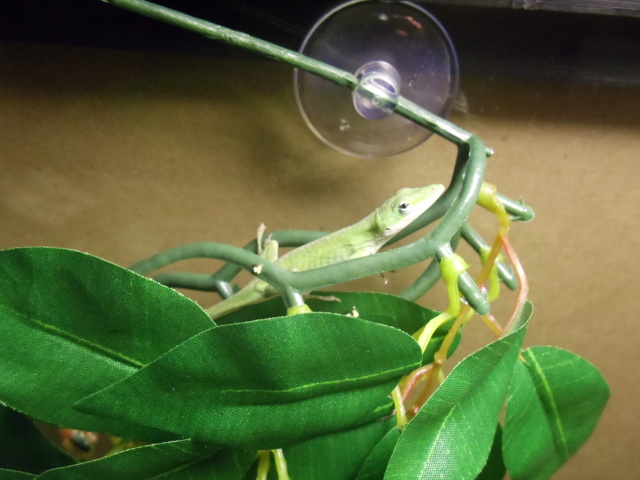 Anole will not eat
QuestionQUESTION: Hi my daughters anole will not eat. W
Anole will not eat
QuestionQUESTION: Hi my daughters anole will not eat. W
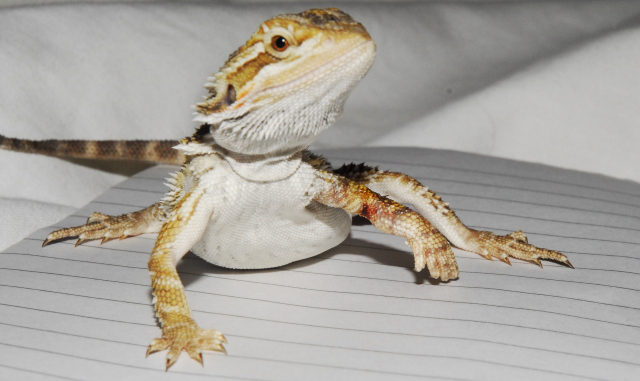 Baby beardy has broken arm
Questionshe still climbs but t
QUESTION: i hatch
Baby beardy has broken arm
Questionshe still climbs but t
QUESTION: i hatch
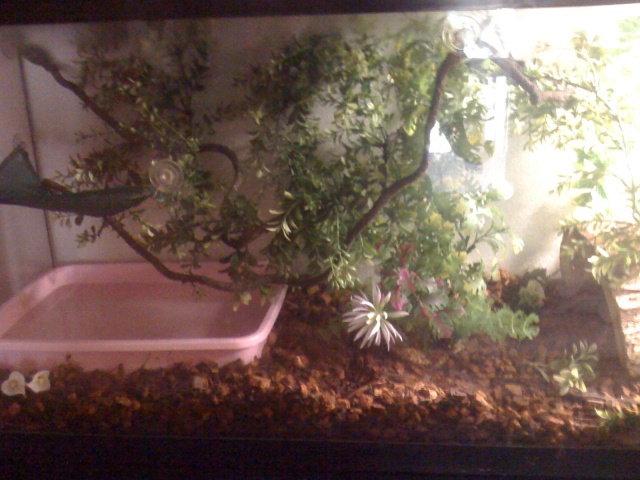 Chinese Water Dragon Not Opening Eyes
QuestionQUESTION: Hello, my name is Morgan and Im an ow
Chinese Water Dragon Not Opening Eyes
QuestionQUESTION: Hello, my name is Morgan and Im an ow
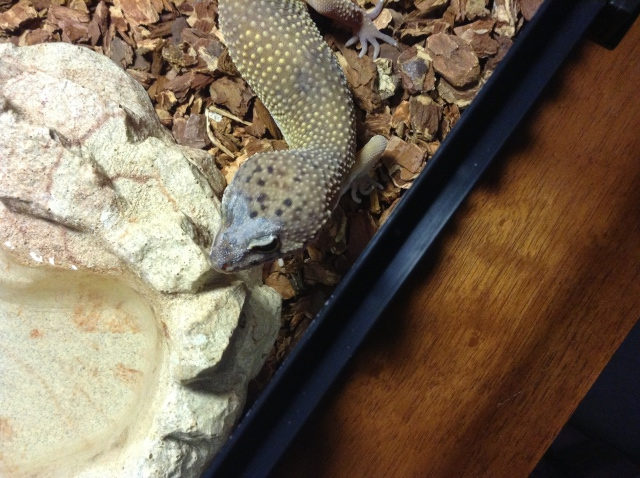 Skin problem with my leopard gecko
Question
Skin problem 1 Skin problem 2
Not
Skin problem with my leopard gecko
Question
Skin problem 1 Skin problem 2
Not
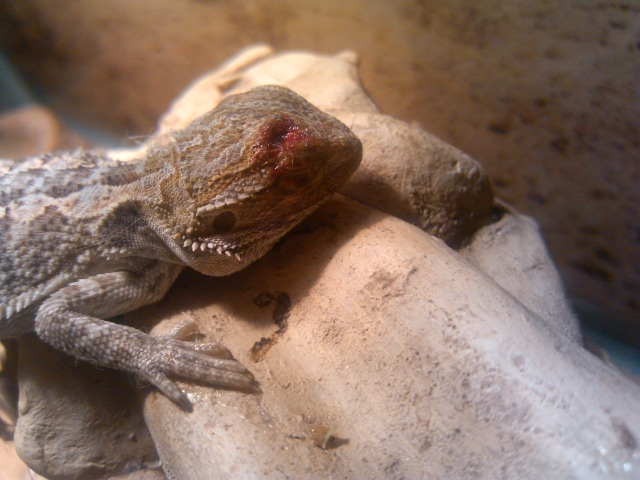 Bearded Dragon eye/head injury
Question
head injury head injury
Please h
Bearded Dragon eye/head injury
Question
head injury head injury
Please h